Boris Johnson government reshuffle - September 2021
Following weeks of rumours, Boris Johnson is reshuffling his ministers. Our team brings together the latest analysis from across the IfG.

Reshuffle 2021: Big changes across government
17 September 2021, 21:35
Long-promised, and possibly long-threatened, Boris Johnson’s reshuffle saw some early drama followed by the slow unfolding of some telling subplots. Three high profile exits from the cabinet – Gavin Williamson, Robert Buckland and Robert Jenrick – and the demotion of Dominic Raab from foreign secretary to justice secretary (softened by Raab’s acquisition of the resurrected position of deputy prime minister) made the instant headlines, as did the continued rise of Liz Truss, Raab’s replacement as foreign secretary, and the promotion of Nadhim Zahawi to the cabinet as the new education secretary. So what motivated Johnson’s decisions? The sacked trio’s low popularity amongst Conservative Party members, and the high ranking of Truss and Priti Patel, who kept her job as home secretary, may well have something to do with it.
Michael Gove’s move to housing minister was portrayed by various newspapers as a sideways shift, demotion or promotion, but handing Gove responsibility for both the government’s flagship ‘levelling up’ agenda and promoting the union suggests that the MHCLG – which may yet get a rebranding - is an increasingly important department. However, Gove’s departure from the Cabinet Office, which also saw its number of ministers fall, makes that department’s influence less certain. The IfG will be watching closely to see what happens to the government’s civil service reform agenda, previously championed by Gove. But away from the headline moves, what else has the reshuffle told us about this government?
Many junior minister changes make this a bigger reshuffle than it first appeared
While the first round of secretary of state announcements suggested that this would be a fairly limited restructuring of government, there was a great deal of movement beneath the cabinet. Many ministers moved between departments, and an eye-catching number of first-time ministers were appointed. Chancellor Rishi Sunak will be working with three new ministers at the Treasury, while Stephen Barclay, Gove’s replacement, is one of three new faces at the Cabinet Office along with the returning Oliver Dowden.
The Department for Education also acquires a new secretary of state and five new junior ministers, while the Ministry of Justice sees four new ministers appointed.
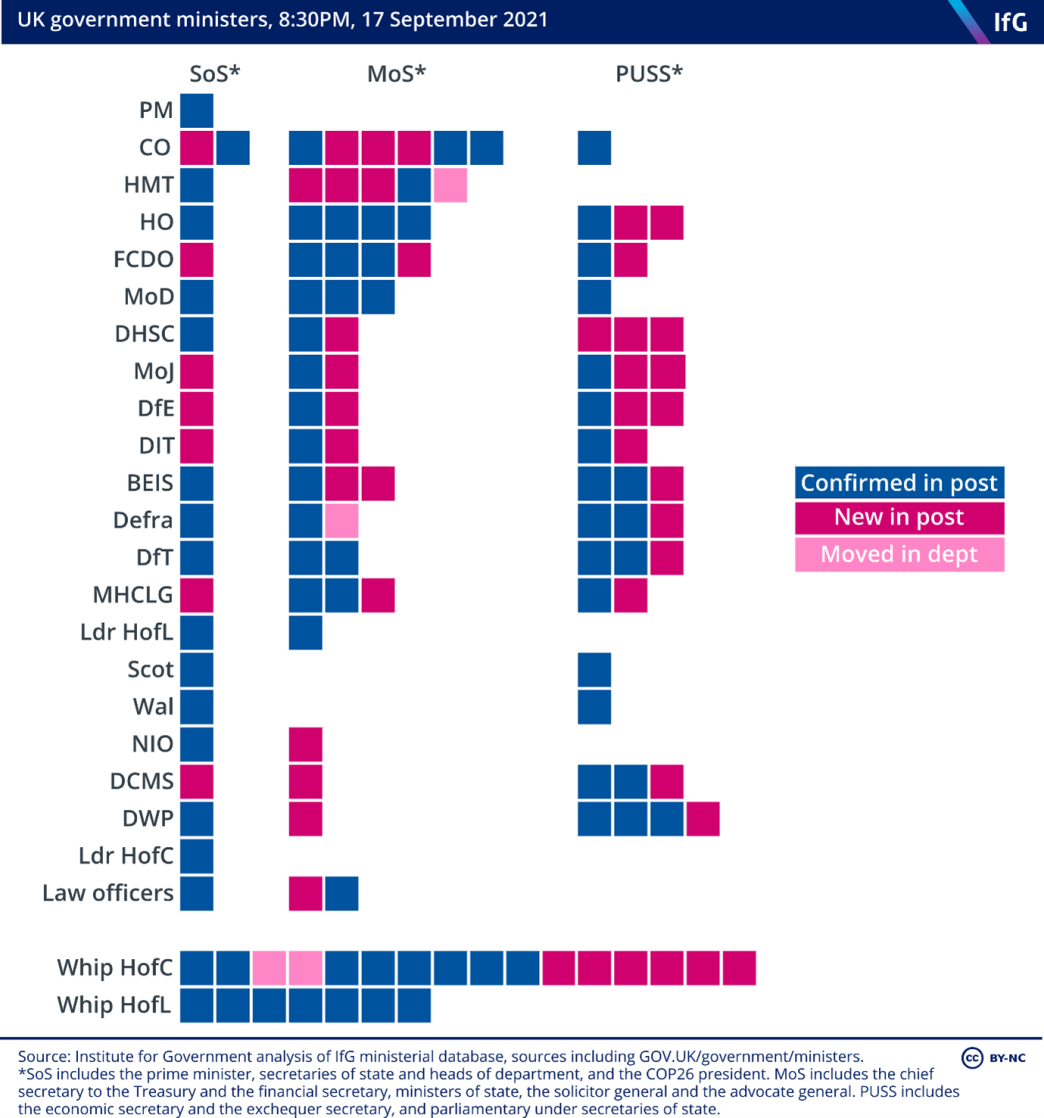
2019 intake is yet to start climbing the ministerial rungs
Despite the political importance of the ‘red wall’ seats won by the Conservatives in 2019, a general election which saw 107 new Tory MPs arrive in Westminster, that intake has yet to make a real mark on the ministerial ranks. The cabinet is still dominated by ministers first elected before 2015, while the majority of ministerial posts are mostly occupied by MPs elected in 2015 and before. Alister Jack, the Scotland secretary, is still the only secretary of state first elected in 2017, with the appointment of Simon Clarke as chief secretary to the Treasury and Julia Lopez as a DCMS minister making them this reshuffle’s highest risers from that intake.
Amanda Solloway, who joins the Whips’ Office, is the first of the 2019 intake to join the ranks of government, but she sat as an MP from 2015 to 2017 before returning to parliament two years later.

Is Johnson starting to level up his government?

A look at the constituencies of this government’s ministers shows a slow rebalancing to the north of England. Rishi Sunak’s Richmond (Yorks) seat had previously made him the most senior figure in government based in the north, but the return of Anne-Marie Trevelyan to the cabinet as trade secretary means the Berwick-upon-Tweed MP is now the northernmost Tory minister.
Sunak is also joined at the Treasury by neighbour Simon Clarke (Middlesbrough South and East Cleveland). However, the departures of Gavin Williamson (Staffordshire South), Robert Jenrick (Newark) and Amanda Milling (Cannock Chase), who lost her job as party chairman, means the cabinet has lost a trio of Midlands-based ministers and is less well represented in that part of the country.
The government has just one minister based in Scotland following David Duguid’s exit from the Scotland Office, while the number of ministers with Welsh constituencies drops from three to two.
The gender balance is improving in Johnson’s government
For only the second time in history, women occupy two of the great offices of state: Truss at the Foreign Office, and Priti Patel at the Home Office.
Raab’s appointment as deputy prime minster means this post, along with that of chancellor, has only ever been filled by a man. The reshuffle has upped the number of women in cabinet from six to eight, but there has been no real change in the share of women in government overall – with an increase from only 31% to 32%. Close attention should also be paid to the make-up of the sub-cabinet committees – all the more important as the cabinet increases in size from 27 to 30 – where key decisions are made. The government's response to the pandemic was largely led by an all-male quartet of Johnson, Rishi Sunak, Michael Gove and, until his resignation, Matt Hancock, with female ministers rarely seen hosting the government’s Covid press conferences.

Johnson has not added experience to this cabinet
Despite the bulk of cabinet ministers having clocked up a good deal of parliamentary experience, cabinet experience has diminished. None of Clarke, Zahawi and Nadine Dorries, the new culture secretary, have previously held cabinet posts, though Trevelyan returns after her stint as international development secretary in 2020. Michael Gove and Sajid Javid are the only survivors of the coalition government, with Gove, first made a secretary of state in 2010, spending more time in cabinet than any of his colleagues.
However, with Johnson’s first cabinet viewed as prioritising loyalty – to the Brexit cause and to Johnson – over experience, much of his team have remained in place through his premiership. Truss’ promotion may well be in part due to her popularity with the Tory grassroots, but she is now, along with Grant Shapps, Priti Patel, and Brandon Lewis, one of the few ministers to have held positions in the coalition. Beyond them, however, there is little in the way cabinet experience. Johnson has not reached for the experience available on the backbenches, such as Jeremy Hunt and Greg Clark, both secretaries of state in the coalition, while experienced junior ministers like Jesse Norman, Nick Gibb and John Whittingdale have all left the government. The return of George Freeman as science minister, however, means some previous ministerial experience has been added.

The Cabinet Office is shrinking... but others are growing
Not only has the Cabinet Office lost the most experienced minister in government in Michael Gove, it has seen a drop in ministers from 10 to nine. Once responsible for co-ordinating the government’s Brexit and Covid responses, the Cabinet Office’s reduction in size suggests Johnson’s focus is now elsewhere. The significance of the department may well become clearer if Gove, who takes his responsibility for promoting the union with him to the MCHLG, takes the relevant officials with him too.
Perhaps signifying the newfound importance of the MCHLG, that department also gains a minister. So too does Defra, where George Eustice remains secretary of state, while DCMS is another department to lose a minister as is, perhaps surprisingly, the Department of Health and Social Care.

Reshuffle round-up - how does this reshuffle compare to the last?
17 September 2021, 17:02
The reshuffle is drawing to a close, so we thought we would take a look at how this one compares to past reshuffles.
Boris Johnson’s last reshuffle, in February 2020, saw a lot of promotions, with the biggest – that of Rishi Sunak to chancellor – caused by Sajid Javid’s unplanned departure. This one has been very different.

There are now more women in cabinet
We have also seen a rise in the number of women attending cabinet, from six to eight. At 27%, this is still short of the 33% women of Tony Blair’s final cabinet in 2007 or the 39% of Gordon Brown’s 2008 cabinet.
Once the final ministerial appointments have been made may well see that more women are now in government.

The Cabinet Office is losing ministers
This reshuffle could see some changes in the number of ministerial posts in each departments, which tells us where the government’s policy priorities lie and how many ministers that Johnson thinks are needed to deliver them.
It already looks like Cabinet Office will lose a number of ministerial size, with this reduction in size a big shift from 2019. Back then, when Johnson first formed his government, the Cabinet Office was the department that gained the most posts, largely to deal with Brexit and the change in role given to the Department for Exiting the EU.

There has been a great deal of ministerial churn in the lower ranks
Overall, Johnson’s cabinet changes have mostly been shuffling the pack. There have only been three departures, with Dominic Raab moving to a junior role. But when the large number of moves for junior ministers are added up, this has been quite a major reshuffle.
Some departments will now have more new ministers in place than those that stayed put. This includes the Treasury, where the prime minister has brought in three new people for his chancellor’s team, including the new chief secretary Simon Clarke.
Both the Ministry of Justice and Department for Education have at least four new ministers, including new secretaries of state. In MHCLG, as it is still known at the close of play on Friday, it looks like a very new ministerial team will be in place, albeit one that that includes people like Neil O’Brien who have already worked extensively on some key policies.

The cabinet is getting larger...
The reshuffle has also seen the number of people attending cabinet grow to 30.

Such a large cabinet makes for an unwieldy forum. This means that much more emphasis will be placed on cabinet committees as the places where decisions are made. But we don’t know yet which committees will now be put in place and who will chair them. Will the prominence of committees on Brexit and Covid operations and strategy be replaced by ones targeting levelling up and the union?
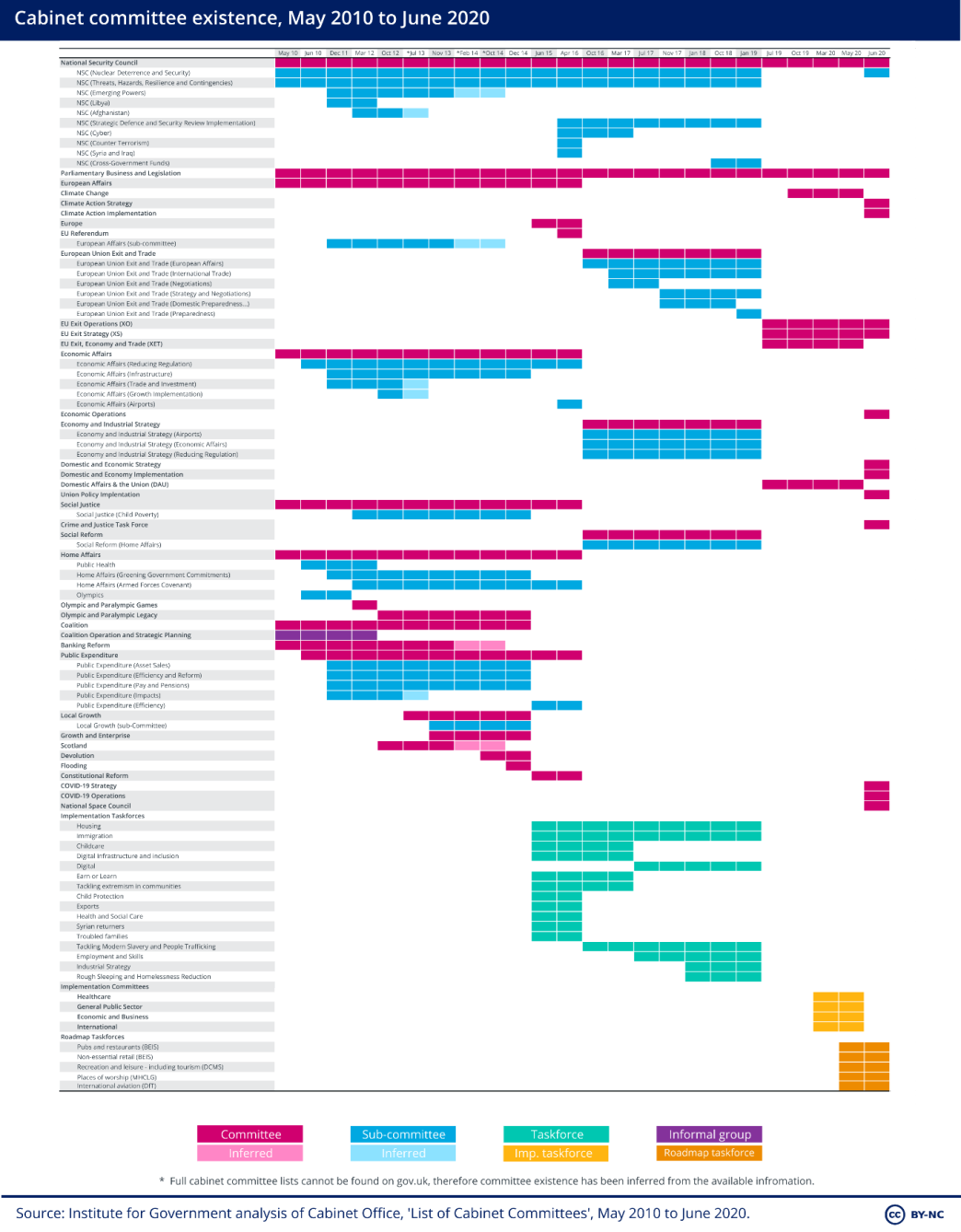
Day three of Boris Johnson's reshuffle
17 September 2021, 14:09
With the final round of appointments underway, we've updated our chart on where things currently stand as of 2pm on day three of the PM's reshuffle.
As you can see, some departments are still missing quite a few appointments. The Ministry of Defence (MoD) hasn't had any junior ministers announced at all – we don't know if that means some ministers are staying in post or not.

16 September 2021, 20:04
A few more announcements trickling in this evening – Matt Warman leaves his post as culture minister, and Conor Burns returns to government as minister of state in the Northern Ireland Office.

UK government ministers at the end of day two of the reshuffle
16 September 2021, 18:52
Here is a look at the government following the recent round of announcements on junior ministerial roles.

As the IfG's Philip Nye points out here, there has been quite a change of personnel at the Treasury – ministers in the three key positions below Sunak are all new in post.
Junior ministers – appointments and departures
16 September 2021, 18:28
Downing Street has confirmed who is leaving the government, which includes Jesse Norman, who leaves his role as financial secretary to the Treasury.
Earlier this year, we spoke to Jesse Norman about the government's levelling up agenda and how it can ensure the public gets value for money on infrastructure – watch it back here.
On appointments, Lucy Frazer and Helen Whately move to the Treasury. Meanwhile, Robin Walker becomes schools minister, replacing Nick Gibb.
Why do junior ministers matter in government? Here's the IfG's Catherine Haddon, with some reflections from the Ministers Reflect archive.
How will Michael Gove’s departure change the role of the Cabinet Office?
16 September 2021, 17:00
The Cabinet Office’s size and remit grew during Michael Gove’s tenure. It led co-ordination of the government’s response to Covid-19 and, before that, its preparations for Brexit. And it has also taken ownership of several of the government’s key policy priorities including levelling up, the union and civil service reform.

The combination of this high-priority policy portfolio and Gove’s profile as one of Johnson’s most experienced ‘fixers’ in cabinet, strengthened the department’s hand in negotiating with the rest of government.
So how will Gove’s move to MHCLG – and his replacement by Stephen Barclay – change the role of the Cabinet Office and its position within Whitehall?
The Declaration on Government Reform, launched by Gove in June this year, included 30 specific actions be undertaken in 2021 to progress the government’s priorities for civil service reform and improve collaboration between ministers and civil servants. There are less than three months to go until those actions are due to be completed.
Gove’s personal leadership of the government reform agenda helped to ensure it remained a prime ministerial priority. Will Stephen Barclay share Gove’s enthusiasm – and influence?
Gove has taken with him his existing responsibilities for levelling up and the future of the union. But it is not yet clear whether he will also take with him the dedicated units working on these agendas in the Cabinet Office. Separating the civil service resource from the minister responsible could cause problems, especially with the levelling up white paper expected in the coming weeks. Moving these teams to MHCLG might further weaken the influence of the Cabinet Office.
It is not just Gove’s departure that could disrupt the Cabinet Office. Oliver Dowden, Nigel Adams and Michael Ellis have all joined the department, while Penny Mordaunt and Julia Lopez have moved on to other roles. This level of movement risks disrupting work as the new team settles in. Barclay will need to determine the role of the post-Gove era Cabinet Office, and set out his own priorities for the department.
Reshuffle at last – casualties and questions
16 September 2021, 16:29
What does the government reshuffle tell us about Boris Johnson’s priorities for government? Who are the biggest casualties? Who are the biggest winners? And does the ministerial shake-up advance – or hinder – the government’s agenda? Read the Institute for Government's assessment – by Bronwen Maddox, Cath Haddon, Tim Durrant and Alex Thomas.
With the reshuffle expected to start up again shortly, here is a reminder of where things are at the moment.

What does levelling up mean for decentralising power?
16 September 2021, 15:30
Michael Gove has emerged from the reshuffle as the key figure in Boris Johnson’s nationwide levelling up agenda – moving to head up the Ministry of Housing, Communities and Local Government (MHCLG) and being given responsibility cross-departmental responsibility for levelling up and the union. Although levelling up is an ambitious project that runs through many departments, MHCLG has been behind key policies such as the £3.6 billion Towns Fund for England, and is also – with its new Wolverhampton office – at the forefront of government efforts to move more civil servants out of London.
Gove, who at the Cabinet Office was in charge of Brexit, the government’s Covid response and the future of the union, has been something of a fixer-in-chief for Johnson. It will be important for Gove to ensure that some crucial aspects of the government’s objectives for levelling up are clarified in the forthcoming white paper, expected later this autumn. The appointment of well-respected MP Neil O’Brien as chief adviser on levelling up earlier in the year showed that Johnson wants to get serious about this agenda but some aspects of it remain ill-defined and contradictory.
One of the big issues he must grapple with is what levelling up really means for the decentralisation of power. So far, many of the government’s levelling up – like the Towns Fund – keep power at the centre by having local areas bid for funding, which does not match the government’s rhetoric about giving communities more of a say. Meanwhile, Gove will also need to address concerns from the devolved administrations about UK government intentions to spend money directly in devolved policy areas.
Which constituencies do the MPs in the cabinet represent?
16 September 2021 15:01
As the IfG's Jack Pannell points out, the new cabinet has slightly more ministers from the north and slightly fewer from the Midlands.

Gender of ministers attending cabinet
16 September 2021, 13:30
The total number of women in or attending cabinet has gone from six to eight, a 33% increase.
Boris Johnson has corrected somewhat the gender imbalance in his cabinet with the loss of three men (Gavin Williamson, Robert Buckland and Robert Jenrick) and one woman (Amanda Milling). Three women (Trevelyan, Dorries, Donelan) and four men are newly appointed to cabinet.

What does Gove's move mean for the union?
16 September 2021, 14:08
Gove’s move from the Cabinet Office to MHCLG could have implications for the union. At MHCLG, Gove will have responsibility for the UK Shared Prosperity Fund – which replaces EU structural funds post-Brexit and forms a key part of the UK government’s union strategy. Combining the union and ‘levelling-up’ briefs seems to reflect the government’s intention to work directly with local councils to spend money directly in Scotland, Wales and Northern Ireland. But this approach has been strongly criticised by the devolved administrations, which argue they are being cut out of spending decisions they used to have control over; the IfG has warned this could undermine the UK government’s objective of bringing the four nations of the UK closer together.
By moving the minister responsible for the union from the centre of government to a historically low-profile department, this may look as though the issue has become a lower priority.
But with Gove also being given responsibility for other key government priorities such as ‘levelling-up’ he will likely continue to have a strong voice in the cabinet.
However, there are many unanswered questions about whether the key constitutional functions currently carried out by the Cabinet Office will move with the minister; whether Gove – now as housing minister – will continue to deputise for the prime minister in high-level meetings with leaders of the devolved administrations; and whether an effective cross-government union strategy can be successfully run from a single department.
The number of ministers attending cabinet has increased
16 September 2021, 13:06
Boris Johnson started out with a large cabinet in historical terms, but used his February 2020 reshuffle to prune the list of attendees quite sharply.
While there was no increase in the number of full cabinet ministers yesterday, three ministers will newly attend cabinet – Nigel Adams, Kit Malthouse and Michelle Donelan – bringing the total number of cabinet ministers closer to historic highs.
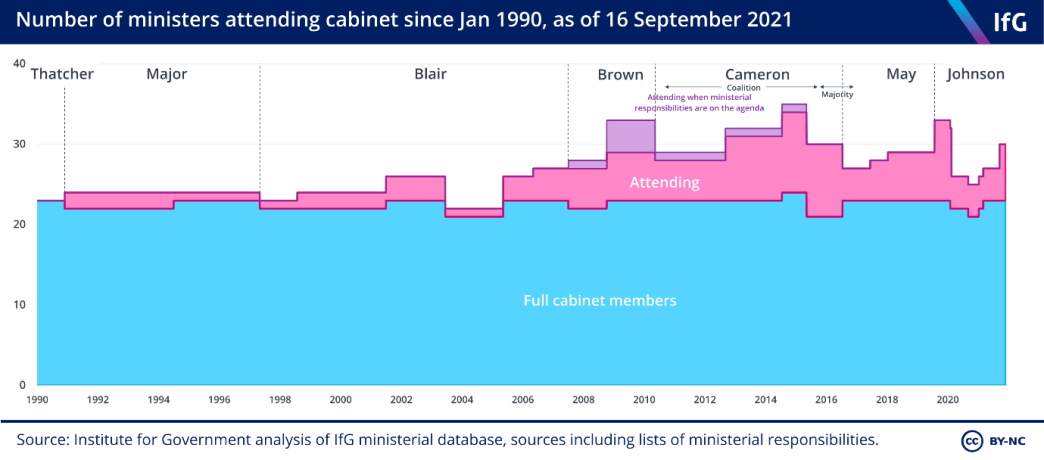
Where are we now on the second day of Boris Johnson's reshuffle?
16 September 2021, 12:21
This is the current state of play – with some notable vacancies such as the solicitor general.

There have been big changes at the Cabinet Office already, and it looks like there's lots of movement still to come. With a rush of junior minister appointments expected later, we'll be updating our live-blog throughout the day – so do make sure you keep following us for the latest developments.
How have cabinet posts changed by gender?
16 September 2021, 11:08
Here is a timeline of how cabinet posts have changed since 1997 by gender.
Liz Truss was the first female lord chancellor and secretary of state for international trade. She is now the second female foreign secretary, after Margaret Beckett in Tony Blair's government.
Meanwhile, HM Treasury has never had a female chancellor, and there has never been a female deputy prime minister.

Dominic Raab inherits a complicated and demanding to-do list at the Ministry of Justice
16 September 2021, 10:57
The Ministry of Justice's (MoJ) budget was cut in real-terms in the 2010 and 2015 spending reviews – although the planned 2015 cuts were never delivered in full. The MoJ’s budget has not been allocated in the upcoming spending review, so it will be competing with other departments for as-yet ‘unallocated’ spending and there are now serious challenges in several of the public services it is responsible for.
There were complaints about the court system, the state of court buildings and waiting times before coronavirus but the pandemic has made these much more pressing. The case backlog has soared, and in the Crown Court it is effectively double pre-crisis levels, after accounting for the complexity of cases. This means much longer waiting times and justice delayed. Eliminating the Covid-related backlog would require a surge in activity over the next couple of years, which can only happen with more funding and more judges. The review of legal aid, which determines how much lawyers are paid for public work, is also due shortly and will be another thorny question the new secretary of state will have to settle.
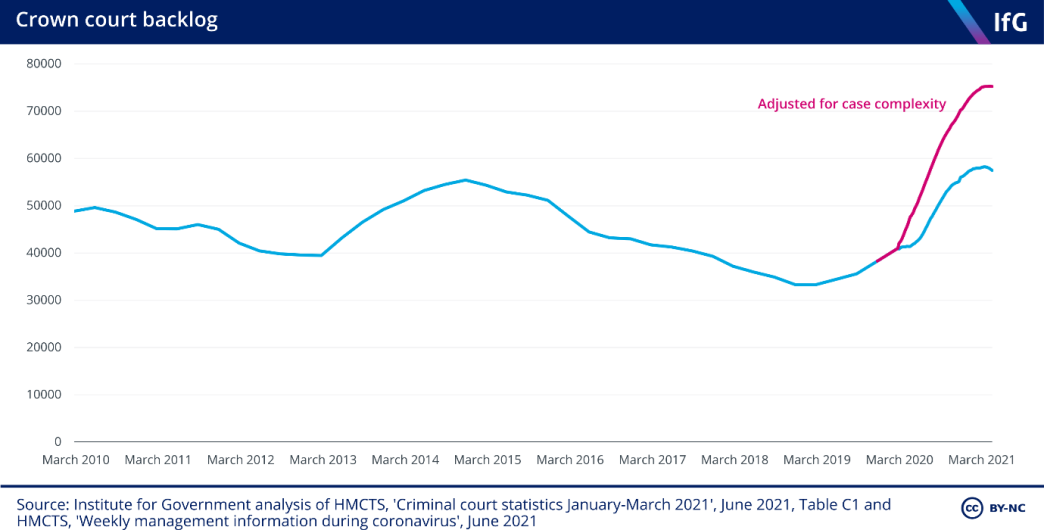
Prisoner numbers are expected to rise rapidly (to almost 100,000 by 2026), which will put pressure on already crowded prisons. Raab will inherit responsibility for a substantial prison building programme to accommodate them, and will need to manage this carefully. Previous IfG research found that over-optimism in the 2015 prison-building programme resulted in the government missing its targets for building new prison places. As the forthcoming Institute for Government and CIPFA Performance Tracker will show, prisoners were locked up for longer during the pandemic – which took a huge toll on their mental health. Raab will have to consider how to balance the reinstatement of rehabilitative activities which many prisoners missed out on with the possible need for ongoing Covid restrictions.
In probation, Raab inherits a system which transitioned back to public sector management in June 2021. Given failures in outsourcing probation, insourcing was the right decision but rolling out the reform without testing it first was risky. Raab will need to monitor – or delegate – the progress of this reform carefully, as we warned last year: “past failures will still be repeated without a careful approach and constant ministerial oversight”.
Nadhim Zahawi needs school contingency plans to minimise disruption
16 September 2021, 10:39
Nadhim Zahawi rejoins the Department for Education, this time as secretary of state. Zahawi will benefit from his previous experience at DfE – where he was children’s minister between 2018 and 2019.
He faces several pressing questions. One will be how to minimise disruption to schools if Covid cases resurge in the autumn. The government’s refusal to make contingency plans for schools and exams in summer 2020 created major problems last year and must not be repeated. How to grade exams in 2022 is another big decision. While all options are flawed, the government needs to make a decision and provide clear guidance to ensure universities, colleges and employers understand the differences between pupils graduating in different years.
DfE also has several claims for more money in the spending review. While the government has allocated large annual increases in school funding until 2022/23, school funding has not been allocated for the final two years of the parliament, and the government has not allocated catch-up funding beyond this financial year. At the end of the spring 2021 term, primary school pupils were, on average, around two months behind in reading and three months behind in maths. Even on highly optimistic assumptions about how much learning pupils lost, Zahawi’s will need to get more funding for school catch-up in the upcoming spending review if he wants to make good pupils’ lost learning.
The department is also responsible for colleges, universities, and children’s social care – all of which were hugely impacted by the pandemic. Children’s social care – where there could be large numbers of children at-risk who were not referred to local authorities during the pandemic – should be a particular concern.
Michael Gove's first priority will be the spending review
16 September 2021, 10:27
The Ministry for Housing, Community, and Local Government’s budget has not been allocated for the upcoming spending review, and the pandemic has put particular pressure on local authority budgets and locally-delivered services – notably social care for children and adults.
Local authorities have not had more than a one-year outlook for government grants since the last spending review in 2015. Providing certainty about local government funding over the next few years should be a priority.

Will the PM bring new talent into government?
16 September 2021, 10:04
Today the prime minister will appoint the rest of the government. As Catherine Haddon says here, this might still mean lots of disruption for some departments, but it should show us how the prime minister is bringing in new talent.
Welcome back to the IfG reshuffle live-blog
16 September 2021, 10:02
There have been a few announcements overnight.
A big surprise was Nick Gibbs' departure as schools minister – a big loss of continuity in the Department for Education, probably far more so than the secretary of state.
And Penny Mordaunt moves from the Cabinet Office as paymaster general to minister of state at the Department for International Trade.
That's it for today (we think!)
15 September 2021, 19:52
We now have confirmation that Suella Braverman is remaining attorney general, and Jacob Rees-Mogg is remaining leader of the House of Commons. That means – we think! – that all the top jobs are filled and there are unlikely to be any more changes today.
One thing that the No.10 updates don't make clear is whether Braverman and Rees-Mogg will continue to attend cabinet. We're assuming they will – because why would they not – but we don't know that yet. We may also find out that Nigel Adams, a newly appointed minister without portfolio at the Cabinet Office, will also attend cabinet – again No.10 hasn't made that clear.
That's all for today! We'll be back tomorrow with all the details on the junior ministerial roles, and more considered reflections on what this means for the government as a whole – plenty more to come we are sure!

Number of ministers attending cabinet grows
15 September 2021, 19:42
We now have confirmation that Simon Clarke, formerly a Treasury and local government minister who resigned last year has been appointed as chief secretary to the Treasury, overseeing departmental spending and the big decisions in the upcoming spending review.
Clarke has been joined in the 'attending cabinet' ranks by Kit Malthouse, who keeps his same role as minister at the Home Office and Ministry of Justice but will attend cabinet, and Michelle Donelan, who similarly keeps her role but will now attend cabinet. When Johnson became PM, he appointed a lot of ministers to attend cabinet, but then cut them back in February 2020 – the numbers are starting to creep up again now. We're still waiting for confirmation on the attorney general and the leader of the House of Commons.

Our director, Bronwen Maddox, has been talking to BBC News about the reshuffle – watch the video below to hear her thoughts.
Cabinet members confirmed
15 September 2021, 18:55
We now have confirmation on the cabinet – Lord Frost and Baroness Evans are staying in post. The only questions about the top team are whether those attending cabinet but not full members – Jacob Rees-Mogg, leader of the Commons, and Suella Braverman as attorney general. Given Braverman only returned from maternity leave last week, we assume she'll be staying in that role for now.
The big question is who is going to take over as chief secretary to the Treasury? Second in command at the Treasury, the chief secretary oversees public spending – an important role at any time, but particularly in the run up to a spending review.

More confirmations
15 September 2021, 18:43
We're getting more confirmations of ministers staying in post, including the secretaries of state for Northern Ireland (Brandon Lewis), Scotland (Alister Jack) and Wales (Simon Hart). How they work with Michael Gove, with his MHCLG+ role including the union, will be a big question for the coming years, not least as the SNP continue to push for another independence referendum.
George Eustice, environment secretary, is also confirmed as staying in post.

Where are we now?
15 September 2021, 18:29
It seems like the reshuffle is winding down for today - we're mainly getting confirmations of people staying in their existing roles. There are a couple of big names still to be confirmed - environment secretary George Eustice among them...

Anne-Marie Trevelyan to trade
15 September 2021, 18:10
We now know that Anne-Marie Trevelyan has replaced Liz Truss at the Department for International Trade, and Kwasi Kwarteng and Sajid Javid are remaining as business and health secretaries respectively.

Trevelyan's appointment means that the Department for International Trade has had more female secretaries of state than male ones – the only department in government to have done so (of course, DIT has only existed for five years).

Earlier in the year, the Institute hosted a day of discussion on the work of DIT and what it has achieved since it was set up five years ago – watch all the events here.
Barclay's back
15 September 2021, 17:40
Stephen Barclay, formerly chief secretary to the Treasury, has been confirmed as the new chancellor of the duchy of Lancaster, taking over from Michael Gove. A big promotion for Barclay, who returns to a full cabinet post after doing the chief secretary to the Treasury role since taking over from now-chancellor Rishi Sunak.

Zahawi to cabinet
15 September 2021, 17:29
Vaccines minister Nadhim Zahawi is now education secretary, after Gavin Williamson was fired earlier today. No10 have also confirmed that Ben Wallace is staying as defence secretary (a sign of whose side the prime minister was on in the Wallace-Raab griping over the Afghanistan evacuation crisis?).
Zahawi is another fast riser, with only a couple of junior ministerial posts under his belt before getting the big job at the Department for Education.
Zahawi will be the sixth education secretary since 2010.

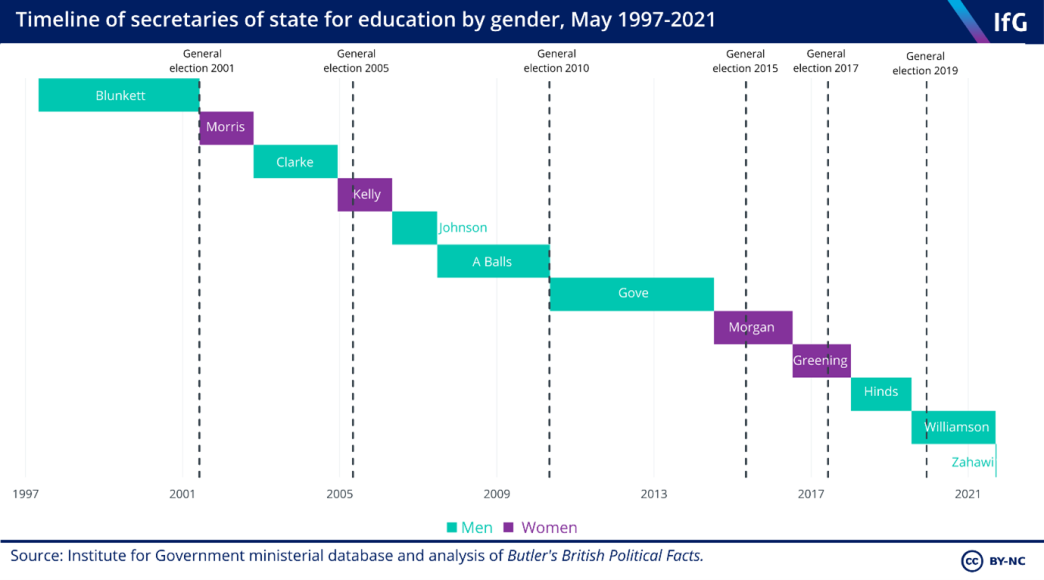
Dowden to party chair, Dorries to DCMS
15 September 2021, 17:10
Oliver Dowden has moved from secretary of state for digital, culture, media and sport to take on the party chairmanship – a big role ahead of the conference. He is replaced at the Department for Digital, Culture, Media and Sport by Nadine Dorries, formerly a health minister.
Dorries only joined the government for the first time two years ago – she has clearly impressed the prime minister over the pandemic.

Dorries is also the tenth culture secretary since 2010 – this department has seen the highest ministerial turnover since that election.

Second female foreign secretary
15 September 2021, 17:02
Liz Truss is the second female foreign secretary, after Margaret Beckett in the Blair government.

Truss has been in government since 2012, in a variety of roles. FCDO is her fourth secretary of state role.

Truss also keeps her role as minister for women and equalities. One of her predecessors in that roles, Nicky Morgan, told us how demanding it was to juggle two jobs:

Ministry of local Gove-rnment
15 September 2021, 16:46
It's official: Michael Gove is heading to the Ministry of Communities, Housing and Local Government. He's taking responsibility for the union of the UK with him from the Cabinet Office, so with that and levelling up he remains responsible for big prime ministerial priorities, despite the seeming demotion to MHCLG.

This is Gove's seventh cabinet job – apart from a few months after the EU referendum, he has been in the cabinet continuously since 2010.
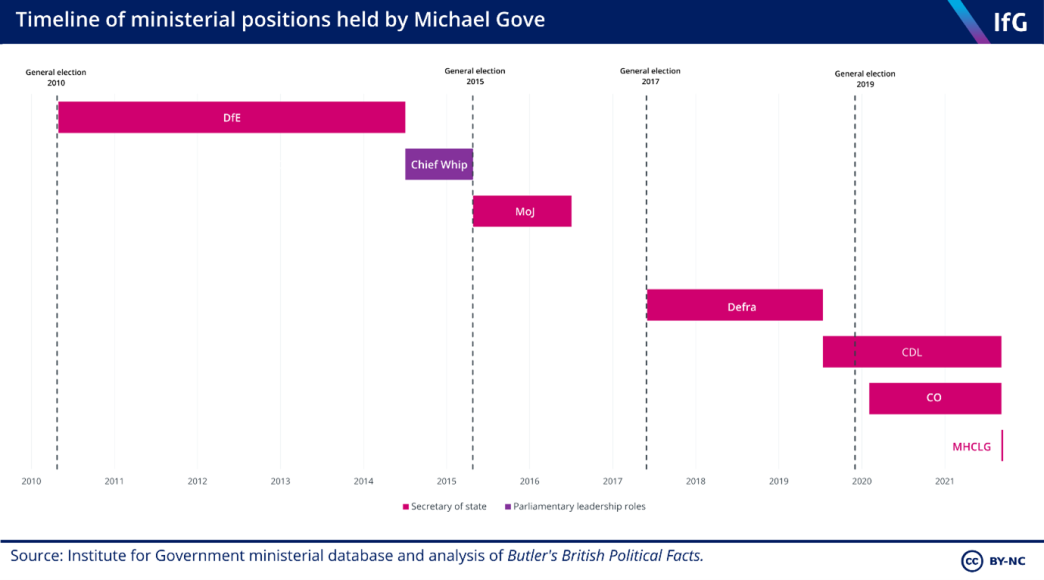
As the new secretary of state at MHCLG, Gove will need to prioritise improving relations between central and local government. In our report on Responding to Shocks we found that “working relationships… are characterised by “bitterness” and “suspicion”… “one interviewee who worked in central government said: “there is a disgraceful, patronising view of local government – that they are less capable, less experienced, more incompetent, and more shambolic than people in central government. They are below the salt.”
Gove is the sixth local government secretary since 2010 (the department has been through several reorganisations and name changes over the years):

What might the appointment of Michael Gove as secretary of state at MHCLG mean for devolution? The department plays a central role in the government’s English devolution plans, so Michael Gove could seek to accelerate reforms to the governance of England’s cities, towns and counties. The government is reportedly negotiating new devolution deals in parts of the country that have so far been left out of the devolution process, as well as potentially transferring further powers to existing metro mayors and combined authorities. The new secretary of state will have the opportunity to shape these deals – and connect them to the wider levelling up agenda – at a time when the government’s overall commitment to devolution is in question.
And although MHCLG has historically been an England-only department, it has begun to take on a more active role in Scotland, Wales and Northern Ireland, and will be responsible for allocating money from the new ‘UK Shared Prosperity Fund’ to local areas across the UK. It is therefore interesting to note that Gove will retain responsibility for relations with the devolved governments, which was a core part of his portfolio at the Cabinet Office. In his new job, Gove will have to navigate a tricky set of relationships with Edinburgh, Cardiff and Belfast as he oversees MHCLG’s ongoing transformation into a UK-wide department.
More broadly, the appointment may also signal a deliberate attempt to join up the government's English devolution agenda with its wider union strategy, which has historically been led from different parts of Whitehall.
Patel stays at Home - and Truss goes to Foreign Office
15 September 2021, 16:09
We now have confirmation that Priti Patel is staying on as home secretary and Liz Truss has been appointed as foreign secretary.

That means two of the four great offices of state are now held by women - which has not been the case since Amber Rudd resigned as home secretary in 2018.
Former foreign secretaries have given us their views on the Foreign Office: Philip Hammond said it was suffering from an identity crisis

And Margaret Beckett told us about the sexism she encountered when she was appointed the first female foreign secretary:
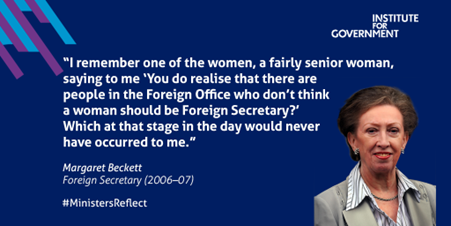
Sunak staying - but Milling going
15 September 2021, 15:48
We now have confirmation from the government that Rishi Sunak is remaining as chancellor and Amanda Milling is leaving as minister without portfolio and party chairman (a big move just a couple of weeks ahead of party conference).
That means the cabinet now looks like this:

Justice Secretary Raab
15 September 2021, 15:45
We now have official confirmation from gov.uk that Dominic Raab has been appointed justice secretary, lord chancellor and deputy prime minister. That makes him the eight justice secretary since 2010 – the department has seen a lot of ministerial turnover.
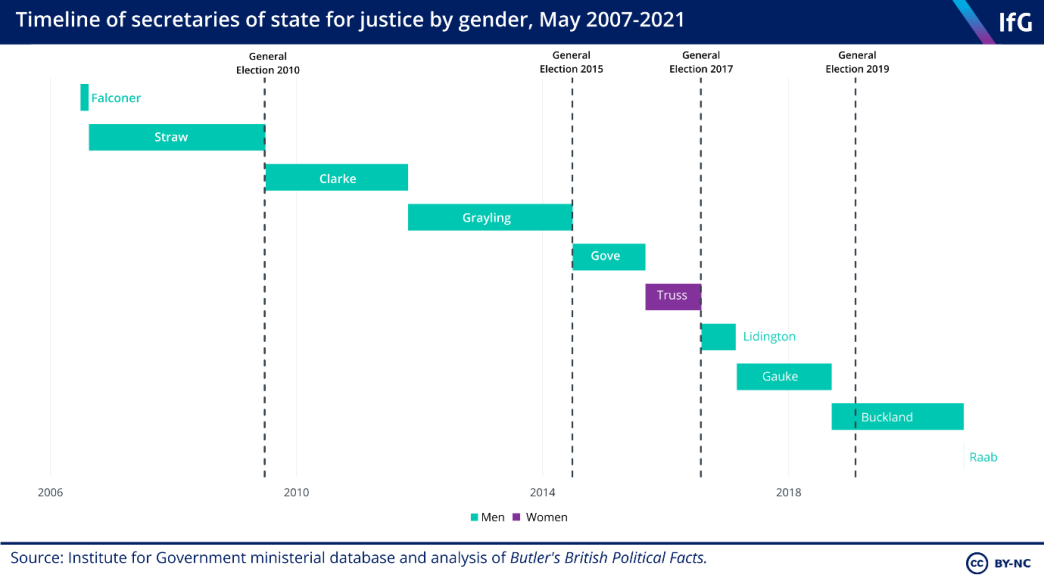
This is also Raab's third cabinet position. Before being appointed to the cabinet under Theresa May as Brexit secretary, Raab held two junior ministerial roles at the Ministry of Justice.

Justice is a big department to get to grips with – one of Raab's predecessors, David Gauke, told us about the risks facing the department:

PM back in No10
15 September 2021, 15:21
According to news reports, the prime minister is now back in 10 Downing Street, which is traditionally where he makes appointments from. So does that mean we've seen the end of the firings?
Currently, these are the gaps in the cabinet - though if current ministers are moved to new roles, more gaps may open up...

What do these changes mean for the spending review?
15 September 2021, 15:03
The big departures from the government so far – education secretary Gavin Williamson, justice secretary Robert Buckland and housing secretary Robert Jenrick – were all responsible for departments with big issues in the spending review. Pupils have lost lots of learning during the pandemic, and criminal courts face the highest backlog of cases on record. Neither the Ministry of Justice, nor the Ministry for Housing, Communities and Local Government have agreed spending settlements in the spending review and briefing new ministers on key pressures will take time.
Our deputy chief economist Tom Pope has more details in his thread here.
Robert Jenrick leaves government
15 September 2021, 14:45
We have another departure: housing, communities and local government secretary Robert Jenrick is out.
Jenrick had a quick rise through the ranks, going from a junior ministerial post at the Treasury to the cabinet table. Will current junior Treasury ministers follow a similar trajectory?

Jenrick attracted criticism last year for his relationship with a wealthy party donor. As our colleague Jill Rutter wrote at the time:
“Jenrick’s position will become untenable if the cabinet secretary cannot back up his assertions. But even if he does vindicate Jenrick, the stench of sleaze could linger.
Governments are vulnerable when it looks as though they are using their power to give unfair advantage to donors or supporters, or if there is the suggestion that access is for sale”
Jenrick has been leading on the government's controversial planning reforms, which is sure to be a big headache for the next housing secretary. And there's the question of the government's net zero emissions target - Jenrick's departure suggests we will have to wait even longer for the housing and buildings heat strategy that has yet to appear and is a key plank in the government’s net zero strategy, important in the run-up to the COP26 conference. We discussed what might be in it at lunchtime today.
What will be waiting for the new education secretary?
15 September 2021, 14:31
Gavin Williamson has gone – and his successor is about to inherit big challenges. In the last 18 months, most children have missed almost half a year’s worth of in-person schooling, as the chart below shows, and the disadvantage gap has grown. At the end of the spring 2021 term, primary school pupils were, on average, around two months behind in reading and three months behind in maths.
After Kevan Collins resigned in June over the size of the catch-up funding package, the next education secretary’s priority will be negotiating with the Treasury in the upcoming spending review, if the government intends to make good pupils’ lost learning.

As former education secretary Nicky Morgan told our Ministers Reflect programme, education secretary is a difficult job because everybody cares about schools:

Earlier this week, Ofsted chief inspector of schools Amanda Spielman spoke to the Institute about how the pandemic has affected schools – watch the conversation here.
Firings before hirings
15 September 2021, 14:24
So reshuffles generally start with the prime minister getting rid of ministers in his office in the House of Commons, and then appointing people to the vacant roles from Downing Street. So far we've got two vacancies that have opened up, but it's still early days:

Buckland out too
15 September 2021, 14:16
Robert Buckland has just confirmed that he is no longer in the government, having been justice secretary and lord chancellor for two years:
As Buckland says, he has been in government for seven years - as solicitor general and a junior justice minister before taking on the top job at the Ministry of Justice when Johnson became PM:
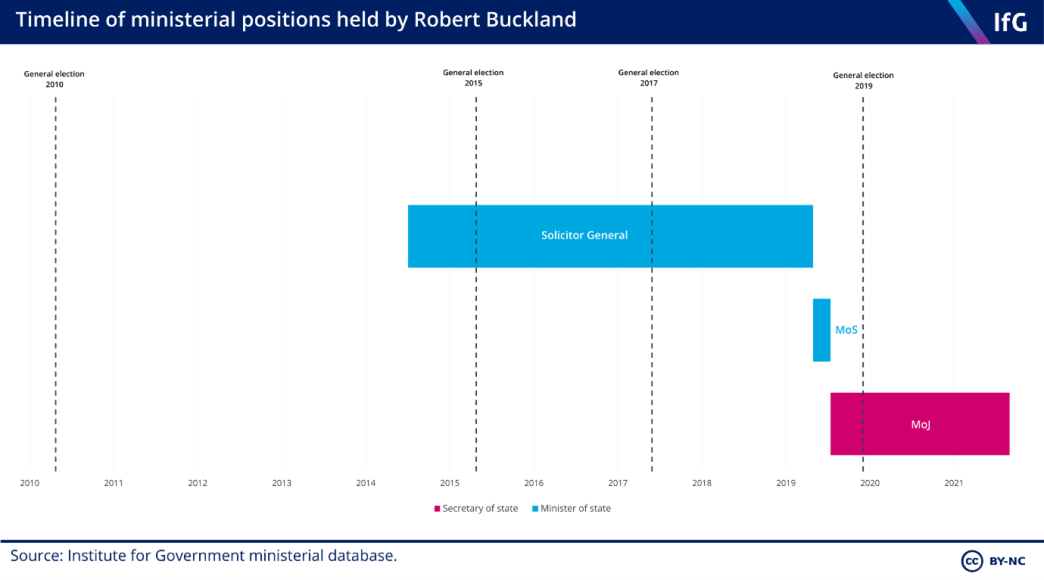
Gavin Williamson out as education secretary
15 September 2021, 13:54
Gavin Williamson has confirmed that he is no longer education secretary – we don't yet know whether he is getting another job in government, although the fact that he's confirmed his departure via a tweet suggests it's unlikely he's waiting for another post.
Williamson had been in government since 2016, with stints as chief whip and defence secretary. He left Theresa May's government after a leak investigation, but was reappointed by Johnson in 2019.

How big do we expect today's reshuffle to be?
15 September 2021, 13:34
One of the big unknowns is how large in scope the reshuffle will be. Johnson used his appointment as PM in July 2019 as a chance to clear out Theresa May's cabinet.

Then the last full reshuffle in February 2020 saw a number of new appointments to the cabinet. So one of the key questions for today is how wide-ranging Johnson decides to make the changes. Does he go big, potentially bringing a new generation of Tory MPs into the cabinet for the first time, or will the message be one of continuity, with only relatively minor changes to his top team?

There is a legal limit on the number of paid cabinet posts that can be appointed: 23. However, several prime ministers have allowed certain ministers to attend cabinet without being a full member of the cabinet. This reached a peak towards the end of the coalition, although Johnson also had a large number of ministers attending cabinet when he first became prime minister. After the 2019 election, however, he reduced the number of ministers attending cabinet – in part, perhaps, at the advice of his former aide Dominic Cummings, who believed a smaller cabinet was more effective.
There are currently 22 paid members of the cabinet, so the prime minister could appoint a new member if he wanted. But he may also invite others to attend without becoming full members.

Will the PM promote 'red wall' Conservative MPs into government?
15 September 2021 13:01
Here we can see the parliamentary constituencies of the current members of the cabinet who are MPs. Most of them are drawn from the south and midlands of England. The only cabinet members with constituencies outside England are Alister Jack, MP for Dumfries and Galloway and secretary of state for Scotland, and Simon Hart, MP for Carmarthen West and South Pembrokeshire and secretary of state for Wales.
With the ‘red wall’ MPs of northern England an important new voice in the Conservative Party, will the prime minister seek to promote any of that group into government? We’ll be tracking the constituencies of all the newly appointed ministers to see where they’re based.

Will the PM bring in new faces into his government?
15 September 2021, 12:52
The current cabinet have different levels of experience in government. Some, like Michael Gove at the Cabinet Office, environment secretary George Eustice and trade secretary Liz Truss have held ministerial roles almost uninterrupted since the coalition years. Others, most notably chancellor Rishi Sunak, are more recent appointments to the top level of government.
One question for a reshuffle is whether the prime minister wants to bring in new faces, or make use of the experience of his existing team, perhaps in new jobs.

What does the whole of government look like?
15 September 2021, 12:34
Beyond the cabinet, this is what the whole of government looks like at the moment. Things to look out for include whether any of the current junior ministers are promoted into the cabinet, whether the number of ministers in a department changes, and whether MPs first elected in 2019 begin to join the government ranks.

Boris Johnson made big changes to the cabinet when he became PM – but there have been few changes since
15 September 2021, 12:27
This is how the cabinet looks at the moment, before the reshuffle – as the day goes on, we will be filling this in with any changes.
Johnson made big changes to the cabinet when he became prime minister (read our live-blog from July 2019). But since then there have been relatively few changes to his top team – Sajid Javid’s departure as chancellor during the February 2020 reshuffle was a big shock. And, of course, Matt Hancock’s resignation earlier this year opened up a spot for Javid to return to the cabinet as health secretary. Will there be big changes or surprises this time round?

Welcome to our reshuffle live-blog
15 September 2021, 12:19
We understand that Boris Johnson plans to start making changes to his team after Prime Minister's Questions.
We will bring you analysis and commentary from across the Institute’s research team, looking at what the reshuffle means for the government as a whole, for individual ministers and for specific departments. Our colleague Alex Thomas has set out here some of the key themes to look out for in the changes announced today.
We’ll also be drawing on our Ministers Reflect archive to understand what the experience of being reshuffled is like – the nervous waiting, the phone calls to the wrong person and of course, for some, the departure from ministerial office.
Keep an eye on this feed throughout the day, and follow our team on Twitter too for all the latest.
- Topic
- Ministers
- Keywords
- Government reshuffle
- Political party
- Conservative
- Position
- Prime minister
- Administration
- Johnson government
- Public figures
- Boris Johnson
- Publisher
- Institute for Government